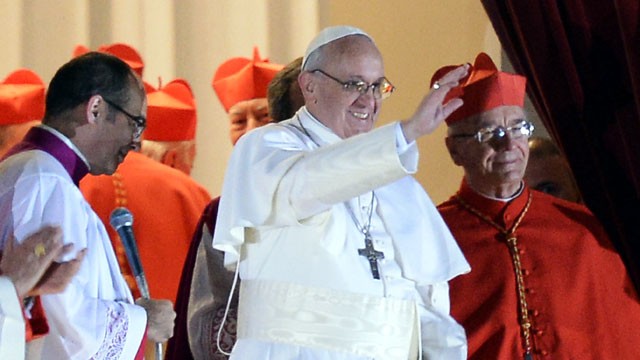Towards the end of the pontificate of John Paul II a genial Melbourne priest said to me: “You just wait until the Pole falls off his perch – the Holy Spirit will rush through the church.” He sincerely believed that John Paul’s conservative leadership was an anomaly and a future pope with a progressive vision would save the church.
It puzzles me that both progressives in the church and journalists continue to talk and write as if change within the church is still possible. There are in fact very few signs that the church, at a structural level, is open to change in any meaningful way.
The ABC’s Michael Rowland interviewing the Sydney Archdiocesan spokesman Fr Brian Lucas, straight after the papal election yesterday asked whether the election of Pope Francis would be a disappointment for moderate Catholics because of the Argentinian’s strong positions on abortion and gay marriage. While in some senses Rowland was absolutely right to raise this, such discussion, assumes the papal election followed the conservative/progressive binaries of other political events. This misses the essential point. There was no progressive candidate for pope. There was not even really a moderate one.
The church will not change its views on abortion: even many of the Church’s most progressive figures such as Jesuit activist Daniel Berrigan are stridently anti-abortion.
While there are windows of hope in other areas of reform – even some Cardinals have broken ranks on the issue of women priests – any such reform will realistically take decades.
I do not hold any real hope for change on the issue of homosexuality and marriage equality. If women priests can conceivably be envisioned in some future church, decades hence, a pro-gay church is a much less obvious, much more distant possibility. But the reality is that the churches are becoming increasingly irrelevant to the legislative agenda around the world as witnessed in the new Pope’s own Argentina where marriage equality was enacted against the then Cardinal Bergoglio’s protests.
As Archbishop of Buenos Aires the new pope said plans for gay and lesbian marriage was a “destructive attempt to end God’s plan.” But even in the strongly Catholic country Bergoglio’s views on gay marriage and adoption won him a rebuke from Argentinian President Cristina Kirchner who said his statements sounded like they came from “medieval times and the Inquisition.”
The election of Bergoglio as Pope Francis took pundits by surprise even though as most of them knew he was the runner-up in the 2005 conclave that elected Cardinal Ratzinger as Benedict XVI .
Although many eyes were on the possibility of a Latin American candidate the 76 year old Bergoglio’s age was seen to count against him. His humble pastoral approach – as we now all know he apparently lived in a sparse apartment rather than the traditional Archbishop’s Palace, cooked his own meals, and traveled by bus – also seemed to count against him in an election where many claimed what the church needed was “Jesus with an MBA”.
As always there are many puzzles presented by this election. They all arise from the fact that the Vatican eschews any sense of transparency in almost any of its internal processes. So no matter what any pundit might predict there are bound to be unforseen twists and turns.
On the one hand Vatican spokesman Federico Lombardi told the media after the election that the choice of the humble priest who took the bus to work amounted to a “refusal of power” and “was absolutely radical.”
However his inexperience in the Roman Curial machinery may mean he will be incapable of leading much needed reform. Perhaps the election of a 76 year old with only one lung is in fact not “absolutely radical” but a “highly pragmatic” move on the part of the curial block of cardinal electors who wish to hold off effective change.
Many commentators have hailed Bergoglio’s election as signalling a strong concern for poverty and social justice. Indeed some of the new pope’s previous statements indicate a radical stance on social inequality and global social debt.
There are big questions about the new Pope’s collusion with the murderous Argentinian regime of the 1970s. His critics claim a disturbing lack of action, during General Jorge Rafael Videla’s brutal and murderous dictatorship.
Bergoglio claimed in a 2010 interview that he had in fact been a strong opponent of the regime behind the scenes.
However the question remains: what does it say about a man who is prepared to stridently and publically lead challenges against legislation to give gay men and lesbians equality while he was not prepared to publically condemn a murderous brutal dictator responsible for “disappearing” up to 30,000 opponents?
Certainly the story of Bergoglio’s true role during the post Peronist dictatorships in Argentina will now become the focus of investigative journalists around the world. It has the potential to become yet another festering sore in the ongoing public scandal of the Catholic Church.
No winds of change swept through the church after the death of John Paul II, as my priest friend hoped. His successor Benedict, has in fact, left it in a much sorrier state. The Cardinal Archbishop of Buenos Aires has symbolically linked himself to the poor but he hasn’t shown any strategic ability to lead widespread structural change or stand up to real injustice. That’s what the church needs: not more theatrical foot washing.





